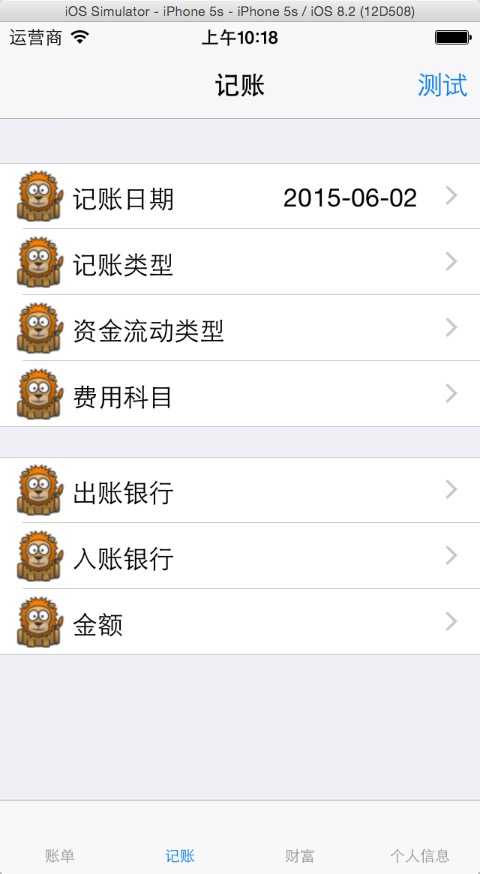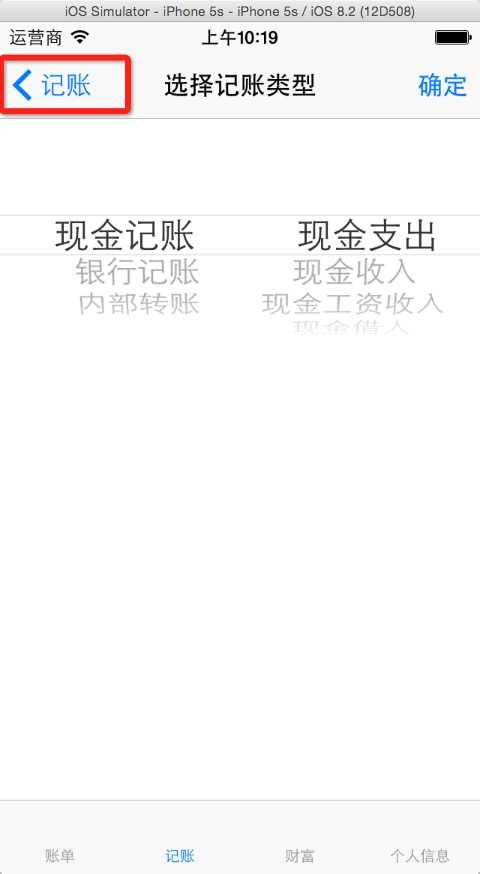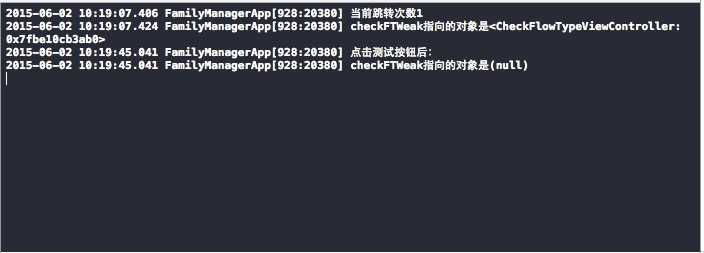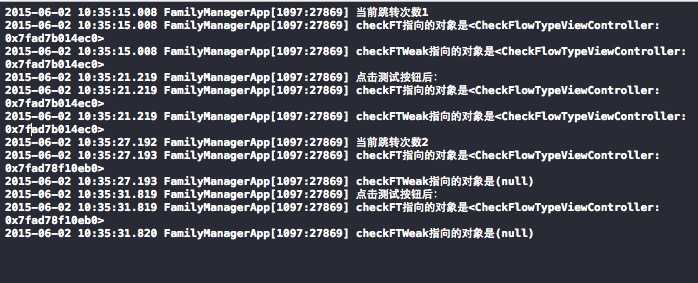标签:
最近在自己做一个小程序,遇到了页面跳转的问题,然后上网一通乱搜,跳转的问题解决了,又有传值的问题。上面两个问题解决了,又发现内存比刚开始时多占用了2M,于是,各种内心纠结,想彻底
搞清楚strong 和 weak 在ARC下到底是怎么个意思,也顺便理清了页面跳转之间的一些联系。
下面开始进入正题:(程序使用了storyboard)
由于页面中使用了一个动态加载的tableview,所以没法在页面中拖segue来实现页面跳转,那么只能在代码中实现页面跳转了。
下面上一下页面跳转的小片段:
页面A的控制器代码 头文件
1 @interface BKViewController : UIViewController<UITableViewDelegate,UITableViewDataSource> 2 @property (weak, nonatomic) IBOutlet UITableView *tableview1; 3 4 @property (strong, nonatomic) UIViewController *checkFT; 5 @property (weak, nonatomic) UIViewController *checkFTWeak; 6 @end
头文件中定义了3个属性,
第一个属性就是对应页面上的一个tableview没什么好说的了。
第二个属性:一个strong 的页面B的控制器变量
第三个属性:一个weak 的页面B的控制器变量
具体干什么,稍后再说
1 @interface BKViewController () 2 { 3 BOOL _isRegistNib; 4 NSDateFormatter *_shortDateFormatter; 5 NSArray *tableData; 6 7 NSArray *kpType;//记账类型 8 int pushCount;//纪录跳转次数 9 } 10 @end 11 12 @implementation BKViewController 13 14 15 - (void)viewDidLoad { 16 [super viewDidLoad]; 17 // Do any additional setup after loading the view. 18 UIBarButtonItem *btnRight = [[UIBarButtonItem alloc] initWithTitle:@"测试" style:UIBarButtonItemStylePlain target:self action:@selector(test)]; 19 [self.navigationItem setRightBarButtonItem:btnRight]; 20 21 _isRegistNib = NO; 22 _shortDateFormatter = [DateFormatterHelper getShortDateFormatter]; 23 //资金类型数据加载 24 kpType = [NSArray arrayWithObjects:@"记账日期",@"记账类型",@"资金流动类型",@"费用科目",nil]; 25 [self loadTableViewData]; 26 self.tableview1.dataSource = self; 27 self.tableview1.delegate = self; 28 29 pushCount = 1; 30 }
上面这段代码主要关注pushCount这个变量,它记录从A页面跳往B页面的次数,初始化为1
ok,准备工作完成了,下面说一下要实验的步骤:
1)从页面A 跳转到 页面B,跳转之前,将weak的 checkFTWeak 指针指向 页面B的对象;
2)然后回到页面A
3)点击测试按钮,测试一下 checkFTWeak现在指向的对象是否还存在
4)我们要有一个笼统的概念:strong会持有对象(引用计数+1),weak不会
代码:
1 -(void)tableView:(UITableView *)tableView didSelectRowAtIndexPath:(NSIndexPath *)indexPath 2 { 3 /* 4 LycTableCellViewDefault *cell = (LycTableCellViewDefault *)[tableView cellForRowAtIndexPath:indexPath];*/ 5 6 NSLog(@"当前跳转次数%i",pushCount); 7 //跳转到选择资金类型页面 8 if (indexPath.section == 0 && indexPath.row == 1) { 9 UIStoryboard *sbMain = [UIStoryboard storyboardWithName:@"Main" bundle:nil]; 10 CheckFlowTypeViewController *cv = [sbMain instantiateViewControllerWithIdentifier:@"checkFlowTypeSB"]; 11 12 if (pushCount == 1) { 13 self.checkFTWeak = cv; 14 } 15 NSLog(@"checkFTWeak指向的对象是%@", self.checkFTWeak); 16 pushCount++; 17 //[self presentViewController:cv animated:YES completion:nil ]; 18 [self.navigationController pushViewController: cv animated:YES]; 19 } 20 } 21 22 -(void)test 23 { 24 NSLog(@"checkFTWeak指向的对象是%@", self.checkFTWeak); 25 }
首先初始化要跳转到的页面B对象 cv,然后将 checkFTWeak 指针指向 cv;接着就打印出对象的信息
当从B 跳回 到A时,点击A页面的测试按钮,再打印 checkFTWeak指针,看看它指向的对象还存在否



通过运行结果,我们看到,当页面从B 返回 A 之后,checkFTWeak指向的对象,也就是那个页面b不存在了。
那么如果让checkFT这个strong类型的属性指向页面b是什么结果呢?
修改tableview选中事件的那句代码为:self.checkFT = cv;
运行结果为:

可以看到,由于checkFT指针是strong类型的属性,那么他会持有页面B的对象,导致内存不会释放
结合上面两个例子,可以总结下面两点:
1)页面跳转时创建的目标页面(就是页面B),在返回后(也就是调用popViewController方法),将会被释放
2)明白了strong和weak的区别,
strong指向的对象不会被释放,除非把指针设置为nil;
而weak不会对指向的对象的引用计数有任何影响,在饮用对象不存在时,会返回nil,替我们做了处理;
那么到这里我还有一个疑问:如果strong类型的指针,本来指向 c,后来又指向d的话,那么c会被释放还是继续存在?
那么继续来改造代码,这个时候前面提到的pushCount参数就起作用了,具体试验步骤如下:
1)从页面A跳转到页面B,同时让checkFT、 checkFTWeak 两种类型的指针指向页面B的对象
2)返回后打印两个指针指向的对象
3)再次从页面A跳转到页面B,但是strong类型的 checkFT指针指向新初始化的页面B,checkFTWeak指针还是指向原来的那个对象
4)返回页面A,打印两个指针指向的对象
修改后的代码:
1 -(void)tableView:(UITableView *)tableView didSelectRowAtIndexPath:(NSIndexPath *)indexPath 2 { 3 /* 4 LycTableCellViewDefault *cell = (LycTableCellViewDefault *)[tableView cellForRowAtIndexPath:indexPath];*/ 5 6 NSLog(@"当前跳转次数%i",pushCount); 7 //跳转到选择资金类型页面 8 if (indexPath.section == 0 && indexPath.row == 1) { 9 UIStoryboard *sbMain = [UIStoryboard storyboardWithName:@"Main" bundle:nil]; 10 CheckFlowTypeViewController *cv = [sbMain instantiateViewControllerWithIdentifier:@"checkFlowTypeSB"]; 11 self.checkFT = cv; 12 13 if (pushCount == 1) { 14 self.checkFTWeak = cv; 15 } 16 NSLog(@"checkFT指向的对象是%@",self.checkFT); 17 NSLog(@"checkFTWeak指向的对象是%@", self.checkFTWeak); 18 pushCount++; 19 //[self presentViewController:cv animated:YES completion:nil ]; 20 [self.navigationController pushViewController: cv animated:YES]; 21 } 22 } 23 24 -(void)test 25 { 26 NSLog(@"点击测试按钮后:"); 27 NSLog(@"checkFT指向的对象是%@",self.checkFT); 28 NSLog(@"checkFTWeak指向的对象是%@", self.checkFTWeak); 29 }
运行的结果:

第一次跳转因为有strong类型的指针checkFT给weak类型的指针checkFTWeak撑腰,所以他俩指向对象一样。
在返回页面A后,发生第二次跳转钱checkFT指向了新的页面B的对象,checkFTWeak指向的对象被释放了,所以打印出了nil
那么又得出了第三个结论:
当strong类型的指针从指向a变成指向b之后,原来的a对象的引用计数将会-1,如果没有其他指针持有它,它变被arc给释放了。然后b的引用计数会+1;
分析结束,如果不对之处希望指出共同学习。
ios基础之 透过页面跳转来认识 Strong 与 Weak
标签:
原文地址:http://www.cnblogs.com/chengzi/p/4545764.html